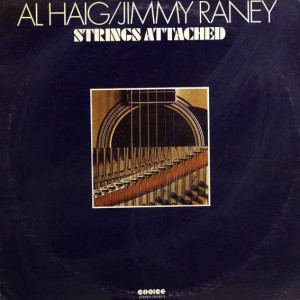Return to Prominence: the mid 70’s
page 1 | page 2 | page 3 | page 4 | page 5 | page 6 | page 7 | page 8 | page 9
After the gig at The Guitar, things started happening for Jimmy. People had not forgotten him; if anything, interest had grown as the large fan turnouts to his gigs demonstrated. Momentum, done for the MPS label in 1974, was his first record as a leader in ten years. The record features some of Jimmy’s favorite standards, including the two originals “Momentum,” a legal rename of his 50’s tune, “Motion” and a new ballad, “We’ll be Together” (which actually has lyrics that have never been recorded).
To be frank, Jimmy didn’t care for this record, the timing or the sound. Also, a glaring misstep with bass/drums re-entry into the final head was left in the final take of “Momentum”. Still, Jimmy’s soloing on this record was so compelling that if you ignore these issues, you still have another gem from Jimmy to study and marvel at. Jimmy was once again at the height of technical and creative abilities. There are several YouTube “dedication” covers (click on the picture at left).
In 1974, he got his first booking at the famous bar/club, “Bradley’s” in Greenwich Village which would become a mainstay for him and would get him the much deserved exposure he needed for getting his career back on track. Although I’m not entirely certain, the bassist Bill Takas on the first gigs was probably responsible for getting Jimmy in the door. Bradley’s was the “it” place for serious players and listeners. Charles Mingus and others could be found hanging around there regularly and it was host to some of the best pianists in jazz from Teddy Wilson to Tommy Flanagan. So the fact that Jimmy was not only playing there but earning the respect of his peers brought his profile to an entirely new level.
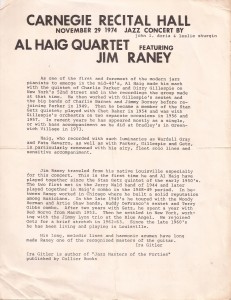 1974 also marked a reunion with his old cohort from the Stan Getz days, pianist Al Haig. They did a concert together in Carnegie Recital Hall in November of 1974 and it was really a special occasion. I was 11 years old and was really proud to have witnessed my father’s comeback in such grand fashion. It’s too bad a recording was never made of it. When Jimmy came up from Louisville, Al and he would often go on long walks through the city. Al knew every piano hall in New York City and the two would go hall hopping from one to another. Al was a tremendous pianist. Usually he would perform classical music for Dad. My father gave Al his Bach-like composition “The Fugue” which was written for two guitars and Al sight-read it cold.
1974 also marked a reunion with his old cohort from the Stan Getz days, pianist Al Haig. They did a concert together in Carnegie Recital Hall in November of 1974 and it was really a special occasion. I was 11 years old and was really proud to have witnessed my father’s comeback in such grand fashion. It’s too bad a recording was never made of it. When Jimmy came up from Louisville, Al and he would often go on long walks through the city. Al knew every piano hall in New York City and the two would go hall hopping from one to another. Al was a tremendous pianist. Usually he would perform classical music for Dad. My father gave Al his Bach-like composition “The Fugue” which was written for two guitars and Al sight-read it cold.
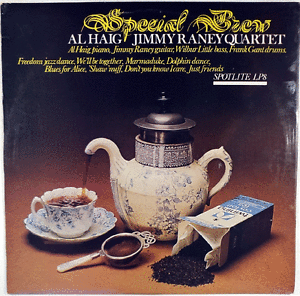
They also did two records together, Strings Attached and Special Brew. These were not quite as eventful. The latter recording was a low-budget outing and featured Al on a clunky electric piano. Strings Attached was a decent outing but Dad noted a change in Al’s playing style, accompanying and repertoire selections. So the blend was not quite as complimentary as it had been back in the old days when they were both dyed-in-the-wool beboppers.
The Strings Attached record was also Doug’s first recorded playing on the cut, “Out of Nowhere”. Doug was still very young but as it turned out, he acquitted himself pretty well and would go on to work with Al on some of his first gigs, most notably Gregory’s on New York’s upper east side. Doug’s official debut record would occur about three years later.
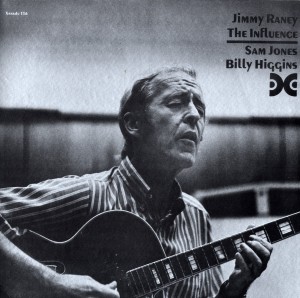 Part of Jimmy’s resurgence in the 70’s had to do with his renewed association with record producer/promoter Don Schlitten. Schlitten was a big Raney fan and was friendly with the Raneys earlier on as both a freelance producer as well as that of the friendship between his first wife and my mother. He helped produce Strings & Swings, a compilation of 1957 Suite for Guitar Quintet and a Louisville, KY concert from 1967 for the Muse label (with Joe Fields).
Part of Jimmy’s resurgence in the 70’s had to do with his renewed association with record producer/promoter Don Schlitten. Schlitten was a big Raney fan and was friendly with the Raneys earlier on as both a freelance producer as well as that of the friendship between his first wife and my mother. He helped produce Strings & Swings, a compilation of 1957 Suite for Guitar Quintet and a Louisville, KY concert from 1967 for the Muse label (with Joe Fields).
Jimmy’s first really good record from this period was 1975’s The Influence, made for the Xanadu label, which had artists such as Jimmy, Barry Harris, Jimmy Rowles, Kenny Barron and Charles McPherson among others. His intent was an “artist first” kind of record company because the profit sharing scheme was supposed to be different than typical record contracts. He was really behind his players, did most of the liner notes and arranged for tours for its members. The most notable being the famous concert in Tokyo, Japan in 1976.
Whether Don ultimately was able to make good on his promise of an “artists first” record company is a matter for debate, but The Influence was an important record for Jimmy. It had a really first class rhythm section which consisted of Sam Jones on bass and Billy Higgins on drums. The concept for the album was essentially to point out how important Jimmy’s influence was on jazz guitar and perhaps to make a historical correction for his lack of recognition. Jimmy is really in fine form for this record. His wonderful solo on “I Love You” has been widely studied and transcribed. And there are great renditions of his favorite standards on the record such as “Body & Soul”, ”It Could Happen to You” and “Get Out of Town” as well as two solo guitar cuts (1 overdubbed). Even the usually taciturn Jimmy mentioned in the liner notes,
“I am really pleased with the way it came out I think it will do a lot for my reputation. I love the Rolls Royce smoothness of the rhythm section.”
He cut another record shortly after, Solo which featured Jimmy jamming with himself on another track, which he had done previously in the 50’s. It is a favorite of many guitarists. He would utilize this concept later for Jamey Aebersold’s instructional record, Play Duets With Jimmy Raney, vol. 29.
It often said that Jimmy played more amazingly live than on record. He commented that there was always something unnatural about studio recording, that being surrounded by your own playing in the cans seems to breed a certain amount of unwanted self-consciousness. The antidote to this came in 1976 on a live recording of Schlitten’s tour in Japan. Live in Tokyo was a three artist concert series with 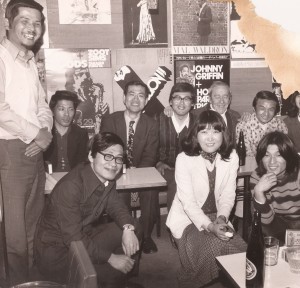 Barry Harris, Charles McPherson and Jimmy as headliners, with bassist Sam Jones and drummer, Leroy Williams in each group configuration. It is regarded as among the finest guitar trio albums every recorded and the audience response was amazing. In Japan, jazz musicians were given the respect they deserved. Dad really loved it.
Barry Harris, Charles McPherson and Jimmy as headliners, with bassist Sam Jones and drummer, Leroy Williams in each group configuration. It is regarded as among the finest guitar trio albums every recorded and the audience response was amazing. In Japan, jazz musicians were given the respect they deserved. Dad really loved it.
I should note something here, though. Throughout the time I have published these biography pages, I have not tried to soften the realities of Dad’s life as it had happened. People may assume that Jimmy’s comeback in the 70’s,which included the Tokyo concert, given its critical success and fan response, was all peaches and cream. It was most definitely not. In fact, throughout his comeback, Jimmy struggled mightily with booze. If anything, it worsened. The difference was that it began to come in waves. On the wagon, off the wagon, usually for around six months to a year. He would be great, in the best shape mentally and musically in his life, but then something would happen and he would fall into drinking. He could literally drink himself into a different personality. This was the case in 1976. In terms of the Tokyo tour, Jimmy actually didn’t have a guitar. He used Doug’s Gibson L7.
On his return from his triumphant Tokyo tour, he actually was drunk on the plane. I know because as luck would have it, he transferred onto the same domestic flight as my mother and I were on which was bound for Louisville. We were visiting Jimmy’s mother during that time. He behaved incorrigibly for about a week until he straightened himself out. Eventually my mom went back to New York but I remained behind With his demons exorcised, we sat down in the kitchen and listened to the music he made on the Japan Tour. It was stunning. He said it was the best record he ever made. He noted how on “Cherokee,” it was the first recording where he felt like he “wasn’t struggling” (an amazing assessment given that there are few if any who could match what he had done at age 24 years before over “Parker 51″. Also the solo to “Darn that Dream” with the unusual Bartok-like leaping phrases [for ex. on the “spot” E-, E-/D etc.] and the trill he was able to get in cleanly). He was very proud of that. “I finally got that in!” he said.
Jimmy Raney is the only jazz guitarist that I know that does vibrato like a fiddle player. Have you noticed how he shakes the neck when laying into a long expressive note? Take note of it. My favorite cut from that concert is “Anthropology”. It’s just a tour de force of rhythm, Charlie Parker quotes, motives and solo architecture. A transcription of the solo is located on my new fan transcription subtab on the homepage. We also listened to the news tapes of his gigs at Bradley’s he had just done with Doug and bassist John Beal. They were really great too.
So my experience with Dad that summer in Louisville was a mix of idolizing and regret at my father’s situation. He was not winning the battle with the bottle but simply riding the wave. For me, I began to develop a healthy dose of fatalism because of his alcoholic cycles. I seemed to know that life could be good but eventually it would screw up. That’s what serial alcoholism does to the family of an alcoholic. He would often get driven to extreme regret in his drunken moments and beg for forgiveness. I was sort of numb. But I did my best to assure him that despite my inner feelings of confusion and perhaps anger that I did. But I did adore him at the same time. When he was straight, he was charming and fun to be around. I also regarded him as the most intelligent, talented musician on the planet; and honestly, there are others not related by blood that thought the same thing.
page 1 | page 2 | page 3 | page 4 | page 5 | page 6 | page 7 | page 8 | page 9
